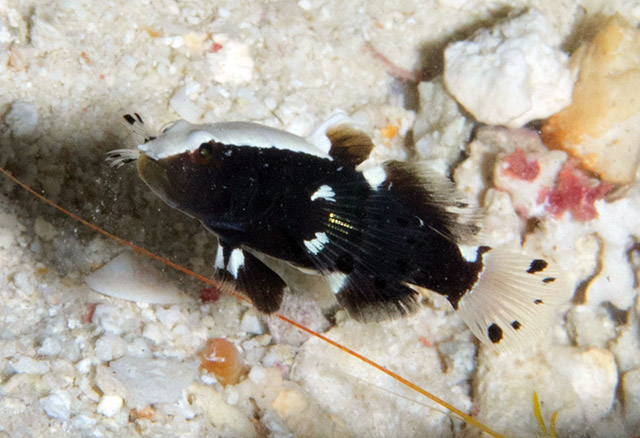| Gobiidae (Gobies), subfamily: Gobiinae |
| 2.71 cm SL (male/unsexed) |
|
reef-associated; marine; depth range 1 - 50 m |
| Western Pacific: from Japan (Ryukyus) to Papua New Guinea (Bismark Archipelago) and south to Australia. |
|
Dorsal spines (total): 7-7; Dorsal soft rays (total): 9-9; Anal spines: 1-1; Anal soft rays: 9-9. Distinguished by the following characters: dorsal-fin rays VI-I, 9; anal-fin rays I, 9; pectoral fin rays 14-16; pelvic fin rays I,5; segmented caudal-fin rays 9+8, including 7+6 branched rays; upper unsegmented caudal-fin rays 5-7; lower unsegmented caudal-fin rays 5-6; longitudinal scales 46-53; transverse scales from origin of anal fin upward and forward to base of first dorsal fin 19-21; transverse scales from origin of anal fin upward and backward to base of second dorsal fin 16-18; transverse scales from origin of second dorsal fin downward and backward to base of anal fin 16-18; scales in preventral midline 2-5; circumpeduncular scales 20-22 (Ref. 90832). |
| Lives in coastal to outer reef habitats, around reef patches on sandy bottoms with rubble; in coral-reef moats and lagoons, outer-reef slopes, or under drop offs (Ref. 48637, 90832). Also reported in areas with patches of fine carbonate sand on subtidal reef flats and seaward reefs and uses the burrow of Alpheus rubromaculatus for refuge. It was observed to constantly wave its large, spotted, fan-like pectoral fins as it hovers close above the entrance to its burrow (Ref. 1602). |
|
Least Concern (LC); Date assessed: 12 March 2014 Ref. (130435)
|
| harmless |
Source and more info: www.fishbase.org. For personal, classroom, and other internal use only. Not for publication.

